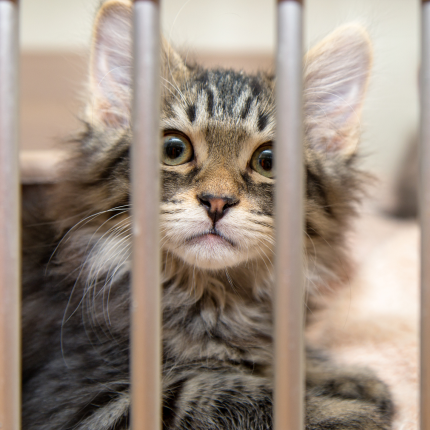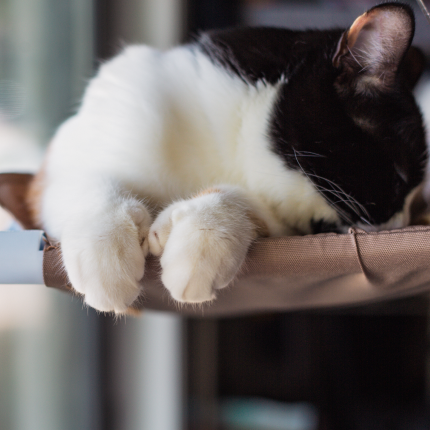Caring for a Kitten Mill Survivor

Fostering a kitten from a traumatic setting can be one of the most challenging and rewarding experiences for any animal lover. As a foster parent, you may encounter a kitten who is not just shy but completely shut down and terrified. The emotional scars from their traumatic past can be visible, and their fear of humans runs deep.
Fostering cats that were specifically victims of a kitten mill is a journey that requires patience, understanding, and a lot of love. Here are some insights and tips for anyone who is promoting or considering fostering a kitten who has come from similar circumstances.
advertisement
Kitten Mill Cats
Kitten mills are large-scale breeding operations that prioritize profit over the well-being of the animals. Cats from these mills are often kept in overcrowded, unsanitary conditions and are not given the opportunity for proper socialization. Many of these cats have never had positive interactions with humans. They are isolated, frightened, and distrustful of people.
The trauma of these early experiences can leave long-lasting effects. Most cats show extreme fear and shutdown behavior. For those unfamiliar with “shut down” cats, they often display behaviors such as hiding, avoiding eye contact, and exhibiting little to no social interest.
The First Steps in Fostering a Kitten Mill Survivor
The most important thing to remember when fostering a kitten mill survivor is that patience is key. Every cat is different, and their recovery process will vary depending on their level of trauma. It may take weeks, months, or even longer, but with time, progress can be made.
1. Provide a Safe and Quiet Space
Spend the first few days in their new home in a quiet, low-traffic area where they feel safe. Providing them with a designated “room” to call their own is important. This space should be stocked with essential supplies, including food, water, a litter box, and comfortable bedding. Be sure to add lots of hiding spaces for them to retreat to if they feel overwhelmed.
2. Let Them Come to You
Building trust with a kitten mill survivor requires a hands-off approach at first. You cannot force them to interact with you; instead, allow them to approach you when they feel ready. Patience is crucial here. Sit quietly in the same room and give them time to observe you from a distance. Avoid any sudden movements or loud noises that could be startling.
3. Slowly Introduce Socialization
Once they start feeling comfortable in their safe space, you can begin introducing gentle socialization. Talk to them softly to help them get used to the sound of your voice. Use treats as a way to create positive associations. Offer treats when they come closer or show any interest in you. This helps build trust and reinforces the idea that humans bring good things.
4. Avoid Pushing Them
Don’t be discouraged if they don’t immediately respond to your attempts at affection. It may take time for them to trust you enough to let you touch them. Sometimes it can take months of building trust before a cat becomes comfortable with human interaction. Forcing affection or touching too soon can set back progress.
5. Create a Calm and Predictable Environment
Fostering a traumatized kitten requires consistency. Establishing a regular feeding schedule and sticking to a routine helps your foster kittens feel more secure. Keeping their environment calm and predictable will allow them to adapt at their own pace. Additionally, providing vertical spaces like cat towers or shelves gives them a place to observe and feel safe without being directly approached.
The Importance of Understanding and Patience
Many cats rescued from kitten mills have had to endure similar conditions and can present significant challenges in their recovery. However, these challenges are not insurmountable. One of the key things to remember is that progress will happen, just not always on your timeline.
Fostering a kitten from a kitten mill is often a slow process, but it can be gratifying. With time, patience, and positive reinforcement, these cats can learn to trust humans again. Some may always remain a bit more cautious and independent, but that’s okay.
Some Additional Tips for Fostering Kitten Mill Survivors
- Consult with a Veterinarian: Kitten mill cats may have medical issues that need to be addressed. Have a vet check that they are healthy and free of parasites or infections.
- Consider Anxiety Relief Options: In some cases, fostering a kitten mill cat may require medication or anxiety relief treatments to help them manage stress. Speak to your veterinarian about potential options, such as natural remedies or calming aids.
- Provide Emotional Support: These cats need to be shown that they are loved and cared for. Consistency in your care will help them feel secure. Even if they don’t show affection right away, they are learning to trust you.
advertisement
A Journey of Patience and Love
Fostering a kitten mill survivor can be an incredible act of kindness. Though the journey may be challenging, the reward is immeasurable. With your patience and understanding, you can help traumatized kitties overcome their fear and trauma and build the trust they need to heal. Whether it takes weeks, months, or longer, every little bit of progress is a step towards her happier and healthier future.
Thank you for considering fostering a kitten mill survivor. With time, compassion, and commitment, these cats can live happy lives, even after enduring such traumatic beginnings.

Featured Articles

The Odd-Eyed Cat (AKA Heterochromia)
Cats are already beautiful and fascinating creatures, but people are bound to take notice when they have something as captivating as two different colored eyes. Odd-eyed cats always have one blue eye paired with either a green, yellow, or brown eye. This form of heterochromia occurs in other animals, including…

Polydactyl Cats: Just More Beans to Love
Polydactyl cats have become extremely popular in recent times. As a result, more and more people are interested in learning more about this six-toed cat and want to get one of their own. If you are a cat lover intrigued by polydactyl cats, you have come to the right place….

Why Do Cats Roll Over Into Their Backs But Not Let You Touch Their Bellies?
It’s common knowledge dogs love to have their tummies rubbed when they freely lay down before you and roll onto their backs. But, if you’re also familiar with cats, you know that when they roll onto their backs with their bellies exposed, rubbing the belly will most likely result in…